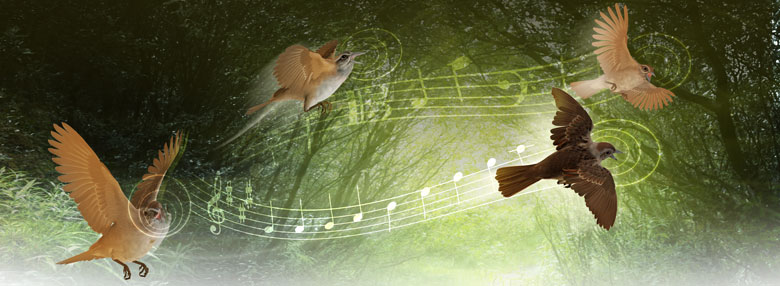Birdsong isn’t for ‘birdbrains’

The Psalmist wrote that the birds of the air “sing among the branches” (Psalm 104:12). Just how well they can sing is becoming increasingly apparent to researchers.
In various bird species,1 pairs (a male and a female) are able to not only sing in tightly synchronized unison but also in antiphonal duets. In songs sung antiphonally, the male and female sing alternating song phrases, frequently in rapid succession and with such precise timing and coordination that people have often mistaken them to be a single bird singing.
Note the second bird to sing in an antiphonal duet must correctly and quickly recognize which song in their musical repertoire the first bird has initiated, in order to correctly contribute the next phrase of the song. Otherwise the duet would end prematurely.
Researchers point out that “rapid and precise acoustic interchanges between animals can indicate remarkable perception and information-processing abilities”—and duetting is a particularly striking example of complex acoustic communication.2 While a variety of other creatures are also capable of producing duets—e.g. frogs, gibbons, whales—researchers say “Birdsongs are among the most elaborate of all acoustic duets.”2 Additionally, “Singing perfectly timed, antiphonal duets poses a substantial challenge, especially given that different phrase types may vary in length and pairs can sing duets at varying distances [necessitating adjustment to tempo].”2 So much for the derogatory term ‘birdbrain’! And in relation to the claim that gibbons and other wild apes are our ‘close evolutionary relatives’, this is yet another instance3 of birds (which are not supposed to be our evolutionary cousins, and which have much smaller brains), being shown to match or surpass apes in cognitive capacity.
Another aspect where evolutionary presuppositions mislead is that they can blunt scientists’ expectations of discovering inherent designer-level sophistication in nature, resulting in surprise when they do. Researchers recently documented “surprisingly rapid” responses of male happy wrens (Pheugopedius felix) to pre-recorded song phrases of females —i.e. within a fraction of a second.2 The researchers wrote: “For this to happen, the male must not only recognize that he has heard a female happy wren sing, but he must also correctly assess which song she has sung (of 30–40 phrase types), determine the appropriate reply from his repertoire (of 30–40 phrase types), and calculate the duration of the female’s particular phrase type so he can accurately time his reply. That some males achieved this feat in the absence of any other cues indicates the sophisticated and rapid cognitive processing underlying this behaviour.”2 (Emphasis added.)
Such sophisticated and rapid cognitive processing also enables groups (i.e. not just pairs) of plain-tailed wrens (Thryothorus euophrys) to sing intricate four-part synchronized choruses, in which the parts for the males and the parts for the females shift back and forth at least twice per second.4 That prompted Science News to state that “when one considers the split-second alternation, the birds’ singing surpasses human vocal virtuosity.”5
Birds sing, and people sing, and fumbled evolutionary attempts to explain the existence of such acoustic abilities doesn’t do them justice. In contrast, the Psalmist’s musings on singing birds in Psalm 104 was actually in context of the greatness of our Maker, the Sovereign Lord of all Creation. That psalm begins and ends with “Bless the Lord, O my soul”—something we too ought to sing, in grateful chorus to God.
References and notes
- Mainly among tropical species. In temperate species it’s often only the males that sing. Return to text.
- Templeton, C., and 5 others, An experimental study of duet integration in the happy wren, Pheugopedius felix, Animal Behaviour 86(4):821–827, 2013. Return to text.
- For other examples see: Wieland, C., Bird-brain matches chimps (and neither makes it to grade school), Creation 19(1):47, 1996; creation.com/alex, and: Crows out-tool chimps, Creation 25(4):7, 2003; creation.com/crows-outtool-chimps. Return to text.
- Mann, N., Dingess, K., and Slater, P., Antiphonal four-part synchronized chorusing in a Neotropical wren, Biology Letters 2(1):1–4, 2006; DOI:10.1098/rsbl.2005.0373. Return to text.
- Milius, S., Just duet: Biologists puzzle over birds’ ensemble vocalizations, sciencenews.org, 24 January 2006. Return to text.





Readers’ comments
Comments are automatically closed 14 days after publication.